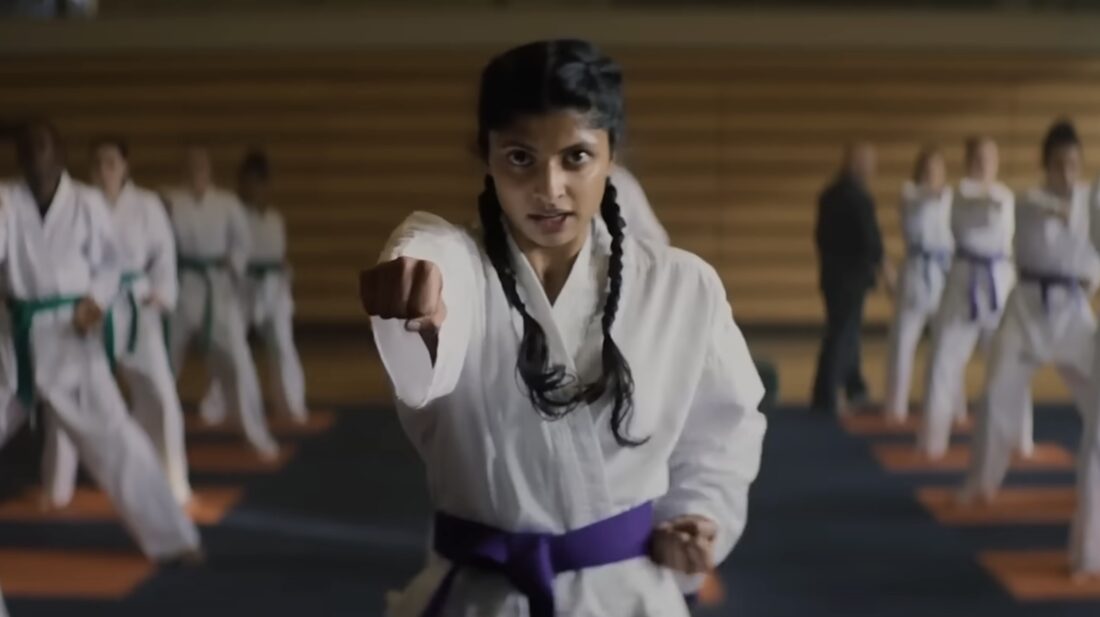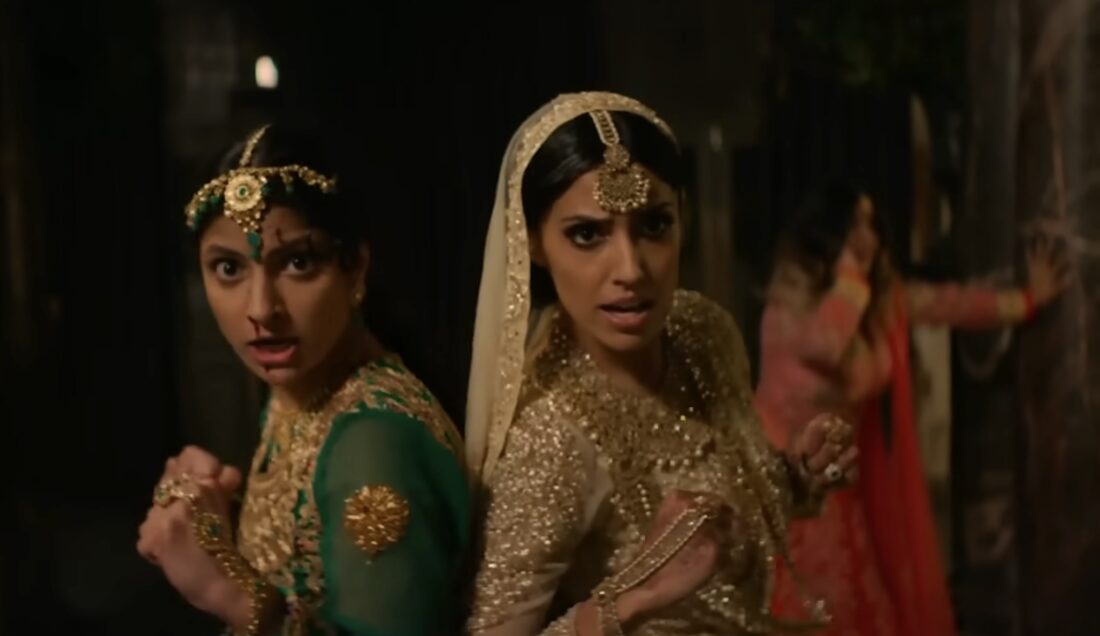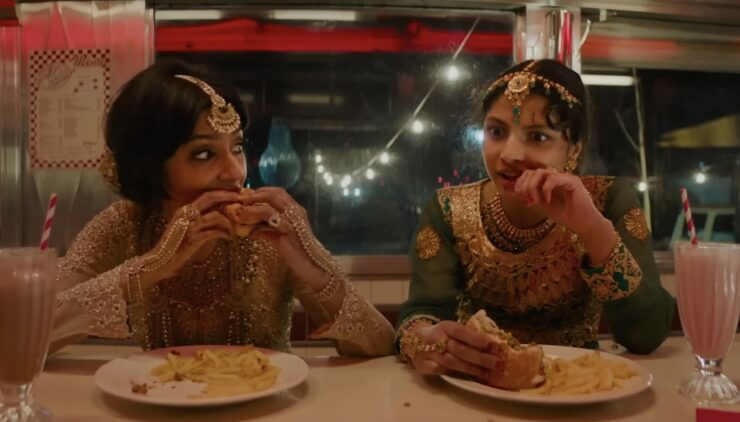As a teenager, I spent most days fixated on martial arts. I practiced Northern Shaolin kung fu, which involved sets of elegant but sharp movements (called “forms”), sparring, conditioning (stamina and strength work), and basic punches and kicks. I watched martial arts films like Tsui Hark’s Once Upon a Time in China and Ang Lee’s Crouching Tiger, Hidden Dragon, I read books about Bruce Lee, and I impulsively demonstrated martial arts constantly at school and at family events. I also enjoyed science fiction, and years later, at university, I became a big fan of Jane Austen. Throughout all that time I was also dealing with the complexity of my identity as a “British Asian”; I’m both an Indian and someone who was born (and has always lived) in the UK.
Last year I heard, much to my surprise and immediate curiosity, about a film that actually combined many of those things into one work: British South Asian experiences, martial arts, and a Jane Austen quality. (It even had a science fiction element, which I found out later.) The film is called Polite Society, written and directed by Nida Manzoor, and I have trouble believing that it exists, even though I have seen it twice now.
Polite Society is about a martial arts and stunts-fixated British Asian teenager named Ria (Priya Kansara) and her increasing panic at the prospect of her art school dropout sister Lena (Ritu Arya) marrying a charming bachelor and geneticist named Salim (Akshay Khanna). Salim also happens to have a truly menacing mother named Raheela, played by Nimra Bucha. As the narrative continues, Ria explores as many options as possible to try and stop the wedding, taking things ludicrously far on more than one occasion, and just when it seems she must surely stop, she discovers that Salim (who is reminiscent of Austen’s deceitful Wickham rather than the Darcy comparison that Ria makes at one point) and Raheela are villains; they are planning to create a clone of Raheela and use Lena as a carrier for said clone. The film can be very silly–and it demands to be taken as both serious and unserious simultaneously–yet it also works, mainly because there is a human foundation to it all. That foundation is Ria’s terrible fear of losing her sister, and how losing Lena also means (to her) losing her own dream to become a stuntwoman.

Film scholar David Bordwell noted (when talking about “classic kung-fu movies”) that martial arts on the screen is a way of conveying character, and Polite Society taps into this style too. Manzoor has said that she wanted to explore the pain of being a teenage girl (when everything feels almost violently intense) through action. With this in mind, I’ll go through some of the most significant martial arts scenes in the film and break down how Manzoor and her team were able to explore characterization through combat in such a powerful manner.
One of the big fight scenes in the film is between Ria and Lena. (Lena has discovered that Ria has been interfering with her relationship with Salim, and confronts Ria in her room.) Their fight melds humor (the shot of their parents listening to their shouting with resignation from downstairs) with the vicious reality of a bitter dispute between siblings. The choreography in this scene echoes this concern; it’s like a mixture of UFC style combat with street fighting, and it’s horrifyingly over the top. Lena uses an elbow strike, a headbutt, a choke, and even burns Ria’s face with a hair appliance. Ria, who is such a fiery and aggressive personality throughout the film, fights quite defensively in this scene, showing her respect for her sister as well as her attachment to her.
As in the rest of the film, Ria doesn’t actually want to hurt Lena, but to save her from what she sees as a terrible fate. She uses what looks like Brazilian jiu-jitsu grappling to try and keep Lena from attacking (essentially holding her down on the ground), and only makes her own harsh attack (a bite) when Lena is choking her. At the end, Lena finally spits out the truth. She’s scared that she’s not good enough to ever become an artist, and this is why she’s decided to move on to marriage. The fight ends on that sad, tender note. Ria hasn’t been able to convince Lena of anything, and Lena is distraught at admitting her own sense of failure. Manzoor wanted this specific fight to be the “bloodiest” because a sibling knows what can hurt you the most, and while we see this in the actual fighting, it also comes through in that final confession from Lena. Ria has pushed her to a breaking point.
Perhaps the scene I enjoy the most is when Ria performs a dance as a diversion at Lena’s wedding to Salim. The dance itself is a homage to Sanjay Leela Bhansali’s Devdas, a famous 2002 Bollywood film adaptation of a novel by Sarat Chandra Chattopadhyay. In the film, a character named Chandramukhi (played by Madhuri Dixit Nene) is dressed in a vibrant green dress and performs a dance set to “Maar Daala,” an unsettling but hypnotic song sung by Kavitha Krishnamurthy and KK. I don’t recall being a big fan of Devdas when I watched it a long time ago, but I’ve always liked that one song. The main line in the chorus of “Maar Daala” apparently translates as “my joy is killing me.” By using this as a song for her sister’s wedding, Ria gives what is normally a happy occasion a troubling, ominous feeling. Her movements reinforce this; she infuses the Devdas choreography with a martial intent in both her expressions and her gestures.
Sometimes Ria’s movements differ, like when she wonderfully throws in a pose from The Matrix at the very end of the song, beckoning to Salim as Morpheus did to Neo in their dojo sparring, or when she quite bluntly mimics shooting a gun at her own head while glaring at Salim. At other times, though, she uses the original choreography and it takes on a new, more aggressive tone due to the context, as in where she slices down with one hand into her palm just as Dixit did in Devdas. Coming from Ria, the motion looks like a chopping attack associated with martial arts. Dance and martial arts are often linked, especially when people describe fights seen on the screen. (Some have compared the beautiful wirework choreography in films like Crouching Tiger, Hidden Dragon to dances.) Polite Society fuses martial arts and Indian dance through Ria’s performance in a way that I have never seen done.

After the dance, Ria ends up alone with Raheela, and has to fight her. Manzoor wanted this fight to feel like Ria was confronting a “Big Boss,” Ria’s ultimate villain. The fight with Raheela is similar to the one with Lena in the sense that Ria is once again the one being overpowered, but the style of this fight, and the emotional element of it, are both very different. The style in this one references classic kung fu cinema; Raheela uses motions that look traditional rather than modern, smoother and more graceful. Her skillful movements represent how slippery she is as a villain. She blocks attacks using the outside and inside of her forearm, and when she settles into a stance at one point it looks similar to something from Taijiquan (Tai Chi), with one hand formed in a hook-like gesture. Instead of brawling like Lena, she catches, redirects, and counters Ria’s strikes. Raheela even parries Ria’s punch using a clothes sash at one point, then snaps it at her to blind her, and uses the same sash to choke her; the fight arranger, Rob Lock, has said that he wanted to emphasize how malicious Raheela could be through her technique, and took these specific moves from Silat, a class of martial arts from South East Asia.
Even outside of the fighting, Raheela is incredibly creepy, but some of the impact behind that creepiness might be lost on members of the audience who aren’t familiar with the cultural context. I was always encouraged to call many elders who weren’t related to me “aunty” or “uncle” as a sign of respect. (I still do.) Elders hold a special place within the hierarchy of South Asian families, which can lead to a truly grim situation when they happen to be malicious. There is a sinister quality to this, where you have to be respectful to someone who, as Hamlet would put it, “may smile and smile and be a villain.” Raheela perfectly embodies this quality, which particularly comes out in the scene where Ria goes to her house to apologize for her behavior, and Raheela seems to accept it at first. Eventually things become more and more threatening, with an unsettling waxing scene and Ria then having to fight off flunkies and escape while Raheela laughs. It’s comedic, but in a way that also feels unfortunately real as it mimics the powerlessness one can feel in front of someone of higher “status.” While this is rooted in a specific cultural context, there is also once again a parallel to the work of Austen in the way outward politeness mixes with an antagonistic undercurrent, before that politeness then falls apart. Much like Austen’s Lady Catherine de Bourgh does with Elizabeth, Raheela attempts to control Ria. Both Ria and Elizabeth are outmatched in experience, wealth, and status, but they behave in unorthodox and rebellious ways, and never give in.
Manzoor still remembers to add a touch of sympathy for Raheela by referencing the lack of choice that women of her generation faced, and the bitterness that can arise from that. We even see another dash of sympathy at the end, when Ria finally defeats her and Raheela is left on the street, reaching out for Lena in despair. It’s ultimately her dream, rather than that of Ria or Lena’s, that shatters.

The lyrics in the ending credits song for the film, by X-Ray Spex, say it all: “Identity is the crisis, don’t you see?” Ria is obsessed with needing to be a “stuntwoman,” Lena is afraid to face failure as an “artist,” and Raheela is fixated on being reborn through a clone, to be the person she thinks she was “destined to be.” Their fighting throughout the film reflects their passions and fears. Raheela with her subtle and masterful movements, Lena with desperate brutality, and Ria, fighting with (as her friend puts it) admirable tenacity. Raheela tells Ria that she has “big dreams,” but really, she’s “utterly unremarkable.” Ria’s response—an elegant jumping spin kick that she has never been able to perform properly before—is the perfect response in a film that approaches martial arts as an integral part of characterization.










